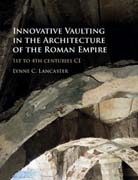
Innovative Vaulting in the Architecture of the Roman Empire: 1st to 4th Centuries CE
Lancaster, Lynne C.
This book studies six vaulting techniques employed in architecture outside of Rome and asks why they were invented where they were and how they were disseminated. Most of the techniques involve terracotta elements in various forms, such as regular flat bricks, hollow voussoirs, vaulting tubes, and armchair voussoirs. Each one is traced geographically via GIS mapping, the results of which are analysed in relation to chronology, geography, and historical context. The most common building type in which the techniques appear is the bath, demonstrating its importance as a catalyst for technological innovation. This book also explores trade networks, the pottery industry, and military movements in relation to building construction, revealing how architectural innovation was influenced by wide ranging cultural factors, many of which stemmed from local influences rather than imperial intervention. Additional resources including extensive searchable databases with bibliographical data and colour illustrations available at www.cambridge.org/vaulting. INDICE: 1. Introduction; 2. Opus Caementicium; 3. Brick barrel vaults; 4. Complex brick vaults; 5. Vaulting tubes; 6. Hollow voussoirs; 7. Armchair voussoirs; 8. Structural form; 9. Vaulting techniques in context.
- ISBN: 978-1-107-05935-1
- Editorial: Cambridge University Press
- Encuadernacion: Cartoné
- Páginas: 256
- Fecha Publicación: 12/11/2015
- Nº Volúmenes: 1
- Idioma: Inglés
